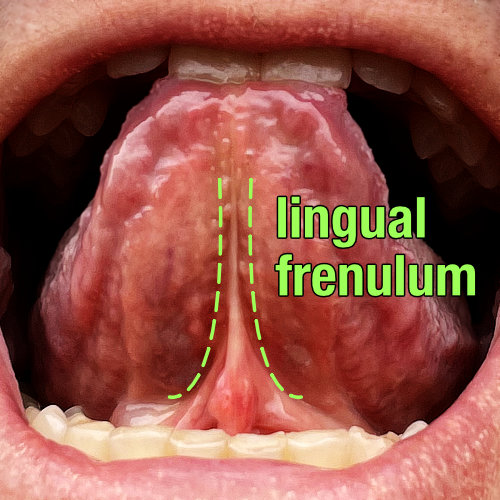Painfully tongue-tied
If you open your mouth wide, can you touch your upper teeth with your tongue?
If not, you might get diagnosed as “tongue-tied,” and warned that it causes TMJ pain, neck pain, and headaches. And so of course you also need tongue stretching exercises, if not surgery. To treat a tongue disability you didn’t even know you had!
What a load of bollocks.
Today I would like to introduce you to this absurd new way to blame painful problems on subtle structural oddities in your body. Will they never end? No, they will not! Not as long as they are profitable. For a detailed discussion of this kind of diagnosis, see my article about structuralism. This is merely one more vivid example of structuralism running amok.

This is a healthy lingual frenulum, reaching all the way from the floor of a wide open jaw up to the upper teeth. No problemo. Of course, it would still be no problemo even if it couldn’t quite reach.
Some people are indeed born with an abnormally short lingual frenulum, the tight strap of connective tissue under your tongue. This occasionally manifests as difficulty with breast feeding. If you say “tongue-tied” to a doctor (or “ankyloglossia,” if you can pronounce it), this is what they will assume you’re talking about.
Frenulopathy is real, but if you got to adulthood without being aware of a problem with your tongue, it certainly isn’t going to be a problem elsewhere in your head. If you need to be told you have any problem with your frenulum, I promise you don’t have one. If you are being told that you are tongue-tied by a dentist or a chiropractor or a physical therapist, you aren’t.
I can easily imagine headaches and TMJ pain as a possible complication of legitimate untreated ankyloglossia, maybe, possibly… but patients who are actually tongue-tied are much more concerned about swallowing. The story here is that this diagnosis is being ridiculously applied to people who have little or no frenulum issue at all. “Pathologizing” healthy people. “Explaining” their head, neck, and jaw pains (which have literally dozens of other possible causes).
Skeptical dentist Grant Ritchey for Science-Based Medicine:
There has been a tremendous uptick of frenum related diagnoses, especially in the dental and ENT communities. Weekend training courses in surgical correction of these disorders are everywhere, often sponsored by laser companies who claim that these “profit centers” will increase the practitioners income and will help the fancy expensive laser “pay for itself”. It can seem that in these cases, the indication for surgical correction of a frenum is the presence of a frenum. While the risks of these procedures are very low, they aren’t zero and they aren’t cheap.
“Myofunctional” therapy and surgery for tied tongues
As always with these kinds of diagnoses, they are just a way to sell a “treatment.” The idea of subtle frenulopathy is mostly just a weird, actionable scapegoat. There are two main treatments recommended to these patients:
“Myofunctional therapy,” a hilariously pretentious name for … tongue workouts. Mostly stretching and reaching. “Drop and give me ten ice cream licks!” Trying to lengthen that frenulum. This is mostly harmless, but I seriously doubt it’s possible to lengthen the frenulum without strenuous effort, if at all. This is a ligament-like structure we are talking about here; it is tough). And a strenous effort might actually cause a headache. And there’s the time, money, and the mental detour.
Because the frenulum is super tough, another “action” often recommended is astonishingly reckless: cut the frenulum. Surgery. What could possibly go wrong? Lots!
What could go wrong
Cara Santa Maria did a great job covering this story for The Skeptics’ Guide to the Universe, episode #845. She tells the hair-raising tale of a woman who got nerve damage and scarring from her first frenulum cutting (frenectomy). That disaster actually restricted her tongue movement, making swallowing difficult.
She was then told by another professional that a second attempt was necessary to fix the consequences of the first… and the second attempt caused even more nerve damage, resulting in permanent loss of feeling in part of her tongue. From frying pan to fire, and from fire to gasoline on the fire.
Such nasty complications are undoubtedly rare, but having this happen to even a single person is unacceptable when both the “disease” and its “cure” are so dubious.
The moral of the story: do not trust stories about surprisingly subtle causes of your aches and pains. Especially when the solution is expensive or invasive.